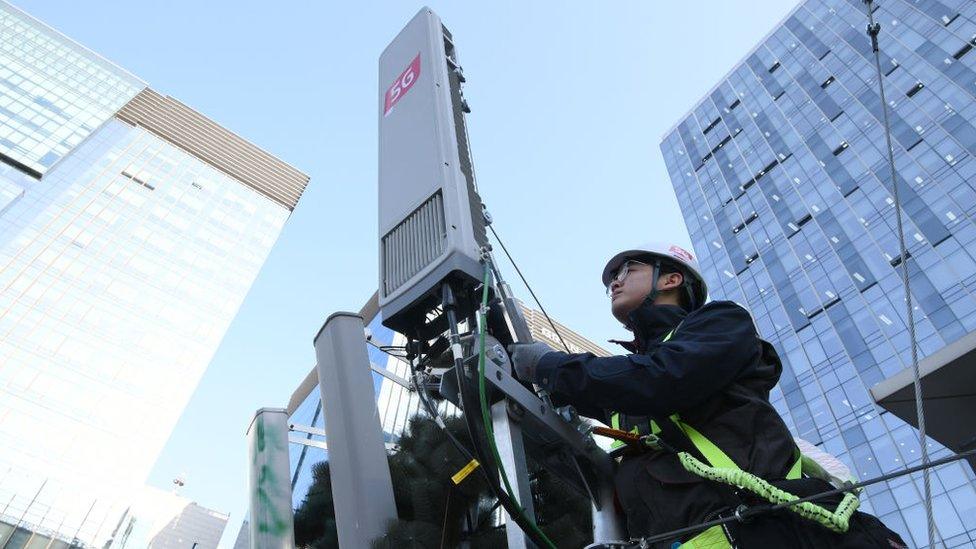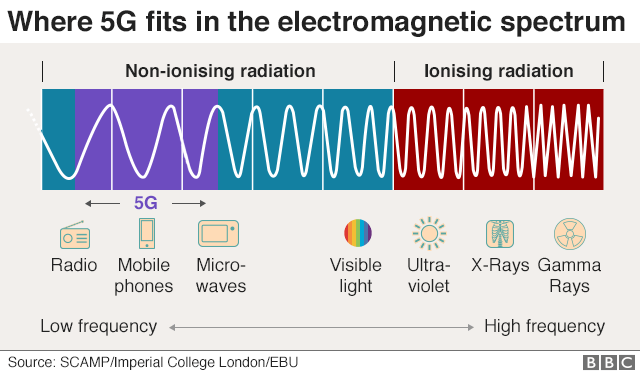Does 5G pose health risks?
- Published

The 5G mobile network has been switched on in some UK cities and has led to questions about whether the new technology poses health risks.
So what are the concerns, and is there any evidence to back them up?
What's different about 5G?
As with previous cellular technologies, 5G networks rely on signals carried by radio waves - part of the electromagnetic spectrum - transmitted between an antenna or mast and your phone.
We're surrounded by electromagnetic radiation all the time - from television and radio signals, as well as from a whole range of technologies, including mobile phones, and from natural sources such as sunlight.
5G uses higher frequency waves than earlier mobile networks, allowing more devices to have access to the internet at the same time and at faster speeds.
These waves travel shorter distances through urban spaces, so 5G networks require more transmitter masts than previous technologies, positioned closer to ground level.

South Korea now has a nationwide 5G network
What are the concerns?
The electromagnetic radiation used by all mobile phone technologies has led some people to worry about increased health risks, including developing certain types of cancer.
However, the WHO together with the International Agency for Research on Cancer (IARC) has classified all radio frequency radiation (of which mobile signals are a part) as "possibly carcinogenic".
It has been put in this category because "there is evidence that falls short of being conclusive that exposure may cause cancer in humans, external".
Eating pickled vegetables and using talcum powder are classed in the same category.
Alcoholic drinks and processed meat are in a higher category because the evidence is stronger.
A toxicology report released in 2018 by the US Department of Health, external, and pointed to by those expressing safety concerns, found that male rats exposed to high doses of radio frequency radiation developed a type of cancerous tumour in the heart.
For this study, rats' whole bodies were exposed to radiation from mobile phones for nine hours a day every day for two years, starting before they were born.
No cancer link was found for the female rats or the mice studied, external. It was also found that rats exposed to the radiation lived longer than those in the control group.
A senior scientist on the study said "exposures used in the studies cannot be compared directly to the exposure that humans experience when using a cell phone", even for heavy users.
Dr Frank De Vocht, who helps advise the government on mobile phone safety says "although some of the research suggests a statistical possibility of increased cancer risks for heavy users, the evidence to date for a causal relation is not sufficiently convincing to suggest the need for precautionary action".
However, there is a group of scientists and doctors who have written to the EU calling for the rollout of 5G to be halted.

Radio waves are non-ionising
The radio wave band - used for mobile phone networks - is non-ionising, "which means it lacks sufficient energy to break apart DNA and cause cellular damage," says David Robert Grimes, physicist and cancer researcher.
Higher up the electromagnetic spectrum, well beyond those frequencies used by mobile phones, there are clear health risks from extended exposure.
The sun's ultra-violet rays fall within this harmful category, and can lead to skin cancers.
There are strict advisory limits for exposure to even higher energy radiation levels such as medical x-rays and gamma rays, which can both lead to damaging effects within the human body.
"People are understandably concerned over whether they might elevate their risk of cancer, but it's crucial to note that radio waves are far less energetic than even the visible light we experience every day," says Dr Grimes.
"There is no reputable evidence," he says "that mobile phones or wireless networks have caused us health problems."
Should we be worried about 5G transmitter masts?
5G technology requires a lot of new base stations - these are the masts that transmit and receive mobile phone signals.
But crucially, because there are more transmitters, each one can run at lower power levels than previous 4G technology, which means that the level of radiation exposure from 5G antennas will be lower.
The UK government guidelines on mobile phone base stations says radio frequency fields at places normally accessible to the public are many times below guideline levels, external.
What about heating dangers?
Part of the 5G spectrum permitted under international guidelines falls within the microwave band.
Microwaves generate heat in objects through which they pass.
However, at the levels used for 5G (and earlier mobile technologies) the heating effects are not harmful, says Prof Rodney Croft, an adviser to the International Commission on Non-Ionizing Radiation Protection (ICNIRP).
"The maximum radio frequency level that someone in the community could be exposed to from 5G (or any other signals in general community areas) is so small that no temperature rise has been observed to date."
Limits to exposure
The UK government says "while a small increase in overall exposure to radio waves is possible when 5G is added to the existing network, the overall exposure is expected to remain low".
The frequency range of the 5G signals being introduced is within the non-ionising band of the electromagnetic spectrum and well below those considered harmful by the ICNIRP.
"The exposure that 5G will produce has been considered in great depth by ICNIRP, with the restrictions set well below the lowest level of 5G-related radio frequency that has been shown to cause harm," says Prof Croft.
The WHO says electromagnetic frequency exposures below the limits recommended in the ICNIRP guidelines do not appear to have any known consequence on health.


